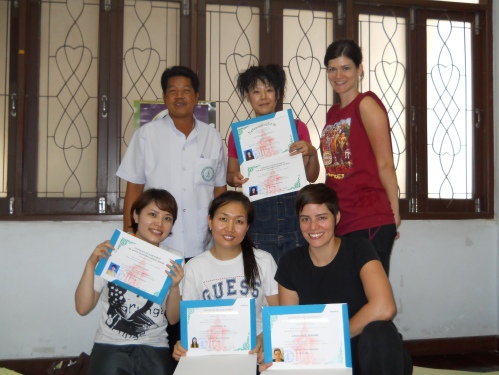I’m playing a little catch-up here, as my vacation in Thailand took over any ambition to post… Now I’m back in the fresh embrace of Portland and looking forward to both reviewing my time in Thailand and enjoying the glorious springtime here! This post is the second half of my post about Thai Massage School in Bangkok.
So, back to the wonders of Wat Pho. I left off at lunch.

After an energizing lunch, we return to school excited for the next leg of our lessons. The afternoons of each day are the most rewarding and the toughest, since we all struggle a bit to remain focused as we are commanded to run through the full routine several times. I appreciate the thorough and relentless quality of the teachers, since the entire massage routine has remained burned into my memory today, one month and many travels (not to mention celebratory wedding-trip whiskey sodas) later.
On afternoons when we finish our routines early, we are rewarded with the opportunity to ask more detailed questions, to learn about specific ailments, and to gain new techniques to weave into our massage routine. A particularly interesting afternoon lesson involved a demonstration of abdominal diagnosis and treatment.
We had a good-humored and complacent model, one of the few men in the class, who allowed a whole gaggle of women to peer at the details of his abdomen while the instructor drew on him with magic marker. There are a few similarities between the Thai abdominal diagnosis and Japanese Hara diagnosis, and one aspect in particular stood out to me. The teacher palpated an area just slightly below and to the left of the umbilicus (the patient’s left) for an area of tension. Depending on the quality of the tension, he would describe some kind of abnormality of the patient’s menstrual cycle, or declare that they had no problems with menstruation. I found this to be an interesting parallel to the Japanese technique of palpating this area for an indication of deep-seated blood stagnation, or “Oketsu.” Furthermore, the instructor claimed that females have more problems with the left side, while males have more problems on the right side, which reflects the TCM idea that the left side relates to “blood,” in which females are often deficient, and the right side relates to “qi,” which males tend to deplete more than women. Innnnteresting.

Kidney area, on either side of umbilicus, in Chinese medicine and in Japanese abdominal diagnosis. In Thai massage, tension here indicates general tension of the entire back (compare to Kidney meridian in Shiatsu).
The Thai technique of treatment is much more heavy-handed than Japanese style massage (at least as I was shown; I’m sure there are different styles of Thai massage). In order to release the deep abdominal and lumbar muscles, rather than approach from an indirect muscle-train or fascial manipulation angle, our instructor gets right into the abdomen and leans in with his entire body weight for a good minute and a half. He demonstrated this technique with almost every student: they would lean down to touch their toes beforehand, then receive treatment, then re-reach for their toes to compare the level of flexibility. Every single student showed markedly improved flexibility. Personally, the treatment itself was uncomfortable, painful, claustrophobic and caused all kinds of strange sensations of blood coursing through my torso in new ways, yet at the same time I found it oddly comforting and completely non-invasive. It was as if I experienced my own internal struggle and then relaxed. The teacher knew the exact point at which I relaxed and subsequently relieved pressure slowly, restoring blood flow into the abdomen. When I stood up, my whole back and abdomen felt lighter and looser. I could lay both hands flat on the ground when touching my toes. This technique exemplifies the approach of Thai massage: it’s a bit quick and dirty, but will definitely produce results.
After several hours of practice on our last day, we all take the test together- a practical exam of 2 hours, plus a quiz about cautions and contraindications for Thai massage. We all receive our certificates and bid each other happy travels! I am so happy to have learned along with such a great group of women.

I was too cool for certificates. (actually I still needed to get a passport photo for the official certificate)
I am happy to say that Thai massage is becoming increasingly popular in the U.S., and Thai Traditional Medicine schools and professional organizations are springing up all over the place. A good one is Thai Healing Alliance International, where you may search for Thai Massage practitioners or find teachers in your area. In Portland, the Naga Center School of Traditional Thai Massage and Medicine offers many different and detailed classes. And although I’m still gaining experience in the Thai massage realm, I will be combining Thai massage with my experience in Shiatsu to create a more effective full-body treatment. This kind of ‘fusion’ is popular, since the two modalities complement and accentuate each other so nicely. I am sad to have had to leave Thailand so soon (2.5 months is not long enough!), but I will be sure to come back for more.













